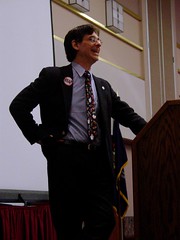Yesterday, I attended “Peer Review Publishing as a Tool for Teaching Biotechnology: The MMG 445 eJournal Experiment Using Production-Level Freeware” by George Garrity, MSU Microbiology and Molecular Genetics.
George will describe a teaching experiment, now in its second year, that he and his colleagues, Terry Marsh, and Scott Harrison, began in MMG 445: Basic Biotechnology. They are producing a peer-reviewed electronic journal of student review articles covering a wide range of topics within the field of biotech. To accomplish this, they are using the Open Journal System that was created at Simon Fraser University.
Given my current interests in exploring collaborative writing software like wikis and Google Docs, I am now trying to think more about the pedagogical aspects of teaching writing in this way. So, I wanted to hear about the ways in which students are able to do online peer review. Garrity began the presentation by giving some context about the course and discussed how the students in this course are a heterogenous group and they need to consider that as they think about writing in the course. He gave some context for biotechnology as a field as well, and discussed how the changing field has also forced him and his colleagues to ask what “basic skills†that have lasting values that they should be covering in the course. He cited the lack of a teaching text for the field as a problem, too.
He shared some insights from his experience in industry, thinking about what types of skills the setting demands from scientists. Multidisciplinary teams, adaptability, and the ability to acquire new skills topped the list, and being a curious, open-minded, problem solving, effectively communicative worker were also there as essential skills. He then looked at the course, and asked, “What is the most effective way to teacher these skills in the context of a course on biotechnology?†and “How do we keep this real?†He shared the evolution of the course from a traditional lecture-based one, to one that was very student-centered. An interesting example that he brought up was how one student group in an earlier semester turned in a paper that had parts plagiarized, and how that experience helped him rethink the way that the course was taught. Also, he discussed how the students moved to a model of leading mini-seminars based on peer-reviewed papers that they had produced. He held them accountable by switching from a pre-set list of three reviews that students would do to randomly collecting their reviews three times throughout the semester (this helped with attendance). They wanted students to read primary literature, write original seminar papers on that literature, and then review one another’s papers and presentations.
Looking at an overview of the course, he shared the background skills (library resources, writing and editing, as well as presentation skills), the enabling technologies and products/processes in microbiology, the student contributions from outside biotechnology, and the intellectual property laws. Resources that they have created for the class include a static web page, an online journal produced by the class with a real publishing system used by publishers’ websites, and electronic journals with “smart reviews.†Garrity also asks the students to read three books by Alley about scientific writing as well as exercises to follow.
Four principals from Alley’s books about scientific writing:
- Understand your audience and what they know in terms of background knowledge and expectations.
- Follow the right format directions in terms of structure, language, style, and illustrations.
- Be sure to use appropriate grammar and punctuation for the format and audience.
- Politically, the writer needs to understand how to remain honest while still satisfying the legal and organizational constraints for the message, audience, and format.
The students complete three assignments throughout the semester.
- Review article covering an area of current research.
- Give a 25 minute presentation (if they only present for 10 minutes, we will question them, intensely, for 15 minutes)
- Scientific and editorial review that must be concise (2000 words), and summarize 10-15 review papers that we and their peers review. The scope of the paper has to be new material, within the last five years.
- They have to agree to the instructions to authors statement on the website.They need to look at multiple sources in the secondary peer-reviewed literature, news articles, trade publications, newspapers, web sites, on-campus seminars. Once they find something to dive into in the primary literature, they then have to look at patent literature, too. They find 10-15 references from primary and secondary literature.
Garrity then described the editorial process from the author, to the editor, to the production of the journal. The students turn in their paper the night before the presentation, and then he makes the editorial assignments about ten minutes before class (randomly). The whole review process takes about a month, from initial submission to the final draft being submitted for the course.
Pedagogical rationale:
- Reading and editing is informative for students as they learn from each other
- With others critically evaluating the scientific quality of the manuscript forces authors to revise
- The reviewers remain anonymous throughout the process, allowing them to experience the peer review process without worrying about the affective responses (positive and negative) that happen in face-to-face reviews.
At this point, Garrity shared the Open Journal System, a free and open-source progam for manuscript trafficking. He then shared their MMG 445 Journal and took us behind the scenes to see how students submit articles and reviews, and how he as an editor can control the work flow.
As I reflect on this presentation, I am amazed at the ways that Garrity and his colleagues have combined active student-centered pedagogy, quality writing instruction with instructor and peer review, and technology as a means to facilitate the process of review.
This seems like a process that many secondary teachers could adopt in their classrooms, and I like the idea of holding students accountable for paying attention to all the presentations and then, at random, three reviews throughout the semester. Overall, I was very impressed with the pedagogical and technical aspects of Garrity’s peer review process.
Like this:
Like Loading...

